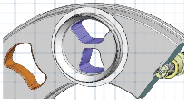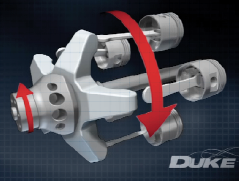Duke Engines High Power Density
The Duke Engine can overcome many of the limits of the conventional combustion engine and achieve power densities approaching those of Formula 1 engines as a port area greater than 37% bore area is practicable in future Duke Concepts, offering greater potential intake flow area than conventional engines. The lack of reciprocating poppet valves also removes the practical limitation that this system imposes on engine operating speed.
PORT AREA
Modern Formulae 1 engine operates at high speed (approx 20,000 rpm), enabled by exotic lightweight reciprocating components and pneumatically sprung valve operating system. The required air flow is achieved through large intake valves requiring a suitably large cylinder bore. In conventioanal high performance 4 valve engines, intake valve flow area is a limiting factor in engine performance. Intake valve area limit of approx 32% of bore area is a basic geometric limitation( 2 x intake valves, each limited in diameter to about 40% of the Bore), with the available air flow area being significantly

smaller than the valve head area, at typically less than (30% bore area). The inlet flow area potential of the Duke engine is approx 25% greater than that of a current Formula 1 engine of similar bore. In the key areas of intake port area and maximum valve/port operating speed, the Duke engine is just not limited to the same extent as conventional engines. In current V3 and V3i versions of the Duke engine port area is less than the potential, limited by legacy architecture. Also while the speed limits of the V3 was around 3500 rpm, the V3i target using revised architecture is 6000 rpm. Hence while the V3 power is 105kW, the V3i target power is “only” 137kw
Performance potential for a "next generation" Duke offers a prospect of naturally aspirated 3.0Ltrs developing 300 kW operating at 8000 rpm from a 100 kg dressed engine (approx 80kg bare engine block). This next generation 3.0Ltr /300kW and 3kW/kg, long engine block would also fit in an 80L packing crate.
This power density target is seen as practically feasible for the next generation of the Duke engine. Greater performance potential (Intake area >>40% bore, speed >> 8000 rpm) would be expected within the theoretical limits that have yet to be explored. As such the performance potential of the Duke engine is outstanding.
High Power Density continued –
THROTTLE RESPONSE
The reduced crank mass also possesses reduced rotational kinetic energy compared to conventional crankshafts and the cylinder block, pistons, and reciprocator spin (in the 5 cylinder engine) at only 1/5th of crank speed. Overall, total rotational kinetic energy is lower than for the equivalent internal combustion engine, meaning there is less resistance to acceleration and deceleration of the engine. The engine therefore has a very quick throttle response.While the naturally aspirated performance prospects of the Duke engine are excellent, pressure charging is also attractive. In most respects the Duke engine could be expected to respond to pressure charging in ways similar to a conventional engine. The demonstrated detonation resistence of the Duke engine offers the prospect of maintaining higher compression ratios with high boost pressures in highly rated SI engines.
The Axial arrangement of the Duke engine also lends itself to variable compression ratio, improving the full load power/partload efficiency trade off typically encountered in fixed compression ratio, highly pressure charged engines.

DUKE ENGINES DATA SHEET
| Duke Engine Data Sheet | Current Build (3.0Ltr)- 2011 Plan Mahle US test |
Potential Duke (3.0L) |
Duke Range Extender Concept (1.25L) |
A1GP (2011 Ferrari) | Nissan VQ35DE* |
| Volume (cuboid packing | |||||
| case - long engine) | 89 | 80* | 30* | 169 ** | 293* |
| Mass (kg) - Long engine | 99 +- 6 | 80* | 41* | 160 | >120* |
| Torque (Nm) | 319* (326#) | 360* | 135* | 550 | 330** |
| Power (kW) | 137* (105#) | 300* | 56/70* (4000/6000rpm) |
450 | 200** |
| Max operating Speed (rpm) | 6000* (3750#) | 8000+* | 6000* | 9000+ | 6400** |
| Specific Power (kW/l) | 46* (35#) | 100* | 44.8/56* (4000/6000rpm) |
100 | 57 |
| Power Density (kW/kg) | 1.15* (0.88#) | 3* | 1.14/1.42* (4000/6000rpm) |
2.8 | <1.4* |
| Type/Configuration | Duke Axial | Duke Axial | Duke Axial | V8 | V6 |
| Cylinders | 5 | 5 | 5 | 8 | 6 |
| Bore (mm) | 95.5 | 105 | 75 | 95.5 | |
| Stroke (mm) | 83.75 | 69.28 | 56.5 | 81.5 | |
| Static displacement (cc) | 2999.5 | 2999.5 | 1250 | 4500 | 3500 |
| Fuel | 91/95 Ron Gasoline/Kero | 95/98 Ron Gasoline | 91/95 Ron Gasoline | Shell E10 102 RON | 91/95 Ron Gasoline |
| Ignition | Sequential Spark | Sequential Spark | Sequential Spark | Sequential Spark | Spark |
| Fuel System | Sequential MPI AAA | Sequential DI | Sequential MPI/AAA | Sequential Twin MPI | Sequential MPI |
| lubrication | Dry Sump | Dry Sump | Wet sump | Dry Sump | Wet sump |
| NVH - Primary forces | 0 | 0 | 0 | 0 | 0 |
| Secondary Forces | Negligible | Negligible | Negligible | Significant | Negligible |
| Primary Moments | 0 | 0 | 0 | 0 | Significant |
| Secondary Moments | Negligible | Negligible | Negligible | Minor | Significant |
| no of parts | 900* | 800* | <900* | >1100* | >1000* |
| fuel consumption (Best bsfc g/kWHr) | <255* | <255* | Competitive with Conventional | Information N/A | 240* |
| fuel consumption (2000 rpm 2 Bar BMEP g/kWHr) |
<365* | <365* | Competitive with Conventional | Information N/A | 365* (2000 rpm 2 Bar BMEP g/kWHr) |
* Projection or estimate
** ancillaries included (estimate -25% for long engine)
# 2010 status test results
